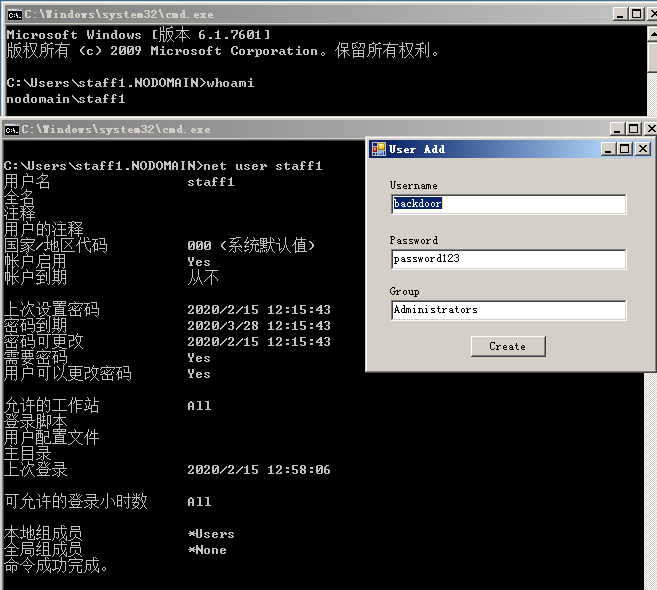一、原理

1.1、二叉排序树的插入




1.2、二叉树的删除

(1)删除度为0的节点,就是最后的叶子节点,直接删除就可以了.
(2)删除度为1的节点,就是爷爷节点接收孙子节点。

(3)删除度为2的节点就是找到该节点的前驱和后继,然后降当前节点与前驱节点的值交换,就变成了前面两度为0或者1的节点删除的情况,然后在进行删除就可以了。


二、代码
#include <iostream>
#include <vector>
#include <string>
using namespace std;
/* 对二叉树的的操作 */
/* 二叉树的节点 */
typedef struct Node
{
int key;
struct Node* Lchild, * Rchild;
}g_Node;
/* 创建一个节点 */
g_Node* getNewNode(int key)
{
g_Node* node = (g_Node*)malloc(sizeof(g_Node));
node->key = key;
node->Lchild = NULL;
node->Rchild = NULL;
return node;
}
/* 向树中某个节点后插入如一个随机数节点:采用递归的方式插入树中元素 */
//g_Node* insert(g_Node* root, int key)
//{
// if (NULL == root) return getNewNode(key);
// //随机插入树的左边或者右边
// if (rand() % 2) root->Lchild = insert(root->Lchild, key);
// else root->Rchild = insert(root->Rchild, key);
// return root;
//}
/* 向树中插入顺序树:创建二叉树 */
g_Node* insert(g_Node* root, int key)
{
if (NULL == root) return getNewNode(key);
//随机插入树的左边或者右边
if (key < root->key) root->Lchild = insert(root->Lchild, key);
else root->Rchild = insert(root->Rchild, key);
return root;
}
/* 从根节点清理掉一个树:采用递归深入清理的方式 */
void clear(g_Node* root)
{
if (NULL == root) return;
clear(root->Lchild);
clear(root->Rchild);
free(root);
return;
}
/* 二叉树打印函数:采用递归的方式,向内打印 */
int tot = 0;
void displayTree_V2(g_Node* root) {
if (root == NULL) return;
int start, end;
tot += 1;
start = tot;
if (root->Lchild) displayTree_V2(root->Lchild);
if (root->Rchild) displayTree_V2(root->Rchild);
tot += 1;
end = tot;
printf("%d : [%d, %d]\n", root->key, start, end);
return;
}
#define MAX_NODE 20
void displayTree_V1(g_Node* root) {
g_Node* queue[MAX_NODE + 5];
int head, tail;
head = tail = 0;
queue[tail++] = root;
while (head < tail) {
g_Node* node = queue[head];
printf("\nnode : %d\n", node->key);
if (node->Lchild) {
queue[tail++] = node->Lchild;
printf("\t%d->%d (left)\n", node->key, node->Lchild->key);
}
if (node->Rchild) {
queue[tail++] = node->Rchild;
printf("\t%d->%d (right)\n", node->key, node->Rchild->key);
}
head++; //如果打印到了结尾了,tail索引就不会在增加,但是head还是增加的,最终就会跳出循环
}
return;
}
/* 二叉树的查找:递归的方式向下查找 */
bool findBinaryTree(g_Node* root, int key)
{
bool ret;
if (NULL == root) return false;
if (key == root->key) return true;
if (key < root->key) ret = findBinaryTree(root->Lchild, key);
else ret = findBinaryTree(root->Rchild, key);
return ret;
}
/* 找到节点的前驱节点 */
g_Node* getProNode(g_Node* root)
{
if (NULL == root) return root;
root = root->Lchild;
while (root) root = root->Rchild;
return root;
}
/*
* 二叉树删除节点:
* (1)删除度为0的节点
* (2)删除度为1的节点
* (3)删除度为2的节点:找到节点的前驱,之后与前驱节点交换,
* 降为删除度为0和度为1的节点。
*/
g_Node* deleteNodeTree(g_Node* root, int key)
{
if (NULL == root) return root;
if (key < root->key) root->Lchild = deleteNodeTree(root->Lchild, key);
else if(key>root->key) root->Rchild = deleteNodeTree(root->Rchild, key);
else {
//删除度为0的节点
if (root->Lchild == NULL && root->Rchild == NULL)
{
free(root); //直接删除
return NULL;
} //删除度为1的节点
else if (root->Lchild == NULL || root->Rchild == NULL)
{ //root的子节点由root的父节点承接
g_Node* temp = root->Lchild ? root->Lchild : root->Rchild;
free(root);
return temp;
}
else //删除度为2的节点
{
g_Node* temp = getProNode(root); //找到节点的前驱
root->key = temp->key; //与前驱交换key数值
//继续递归调用,删除掉交换值后的节点,变成度为0、1的节点删除问题。
root->Lchild = deleteNodeTree(root->Lchild, temp->key);
}
}
return root;
}
int main()
{
g_Node* root = NULL;
for (int i = 0; i < MAX_NODE; i++) //创建二叉树
{
root = insert(root, rand() % 100);
}
displayTree_V1(root);
displayTree_V2(root);
int data = rand() % 100;
bool ret = findBinaryTree(root, data);
printf("find:%d, %d\r\n", ret, data);
deleteNodeTree(root, data);
displayTree_V2(root);
clear(root);
return 0;
}最终的运行结果如下所示:




















